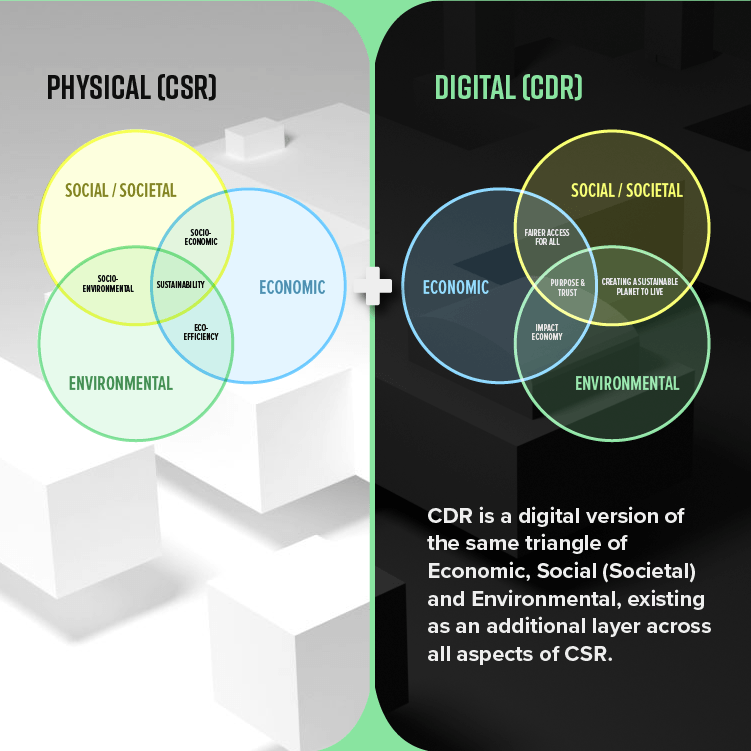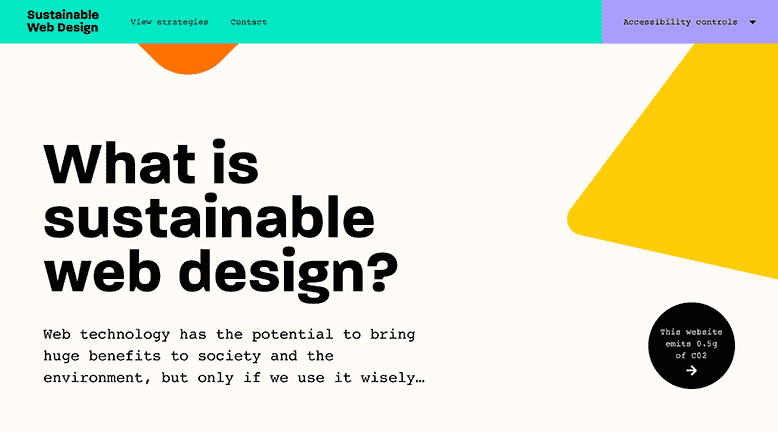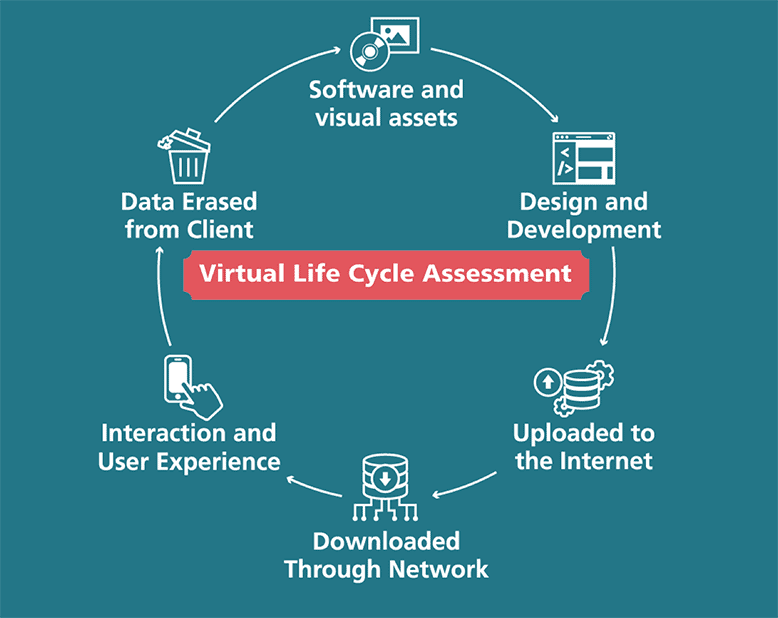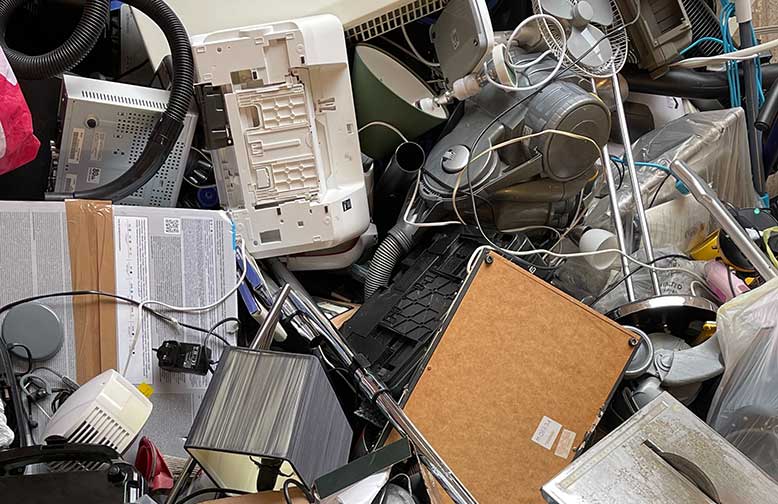Environmental Digital Responsibility

In this post, we explore how Environmental Digital Responsibility can help you better understand the ecological consequences of your organization’s digital choices.
We have covered the internet’s massive environmental impact on this blog since 2013, the year we launched our web sustainability tool Ecograder. The rise of AI, blockchain, and other emerging technologies in recent years has only made the situation worse:
- Energy & emissions: From data centers and network hardware to end user devices, everything on the web requires vast amounts of electricity to operate. This produces around 4-7% of annual global emissions each year.
- Device manufacturing: Producing hardware—computers, smartphones, and other internet-connected devices—involves resource extraction and includes manufacturing processes that produce waste and associated emissions.
- E-waste: When devices reach the end of their lifespan, they become electronic waste (e-waste), which can pose environmental issues if not properly recycled. ‘Planned obsolescence’ that’s built into our purchased devices, is a significant driver of e-waste.
- Water use: A single data center can use millions of gallons of water every year. The number of data centers is expected to double within the next decade.
- Land use: The physical infrastructure needed to support the internet, including data centers and transmission lines, takes up significant land space.
These are problems of scale to which we all contribute through using the internet. However, Big Tech companies must also be held accountable to embrace more circular, environmentally-friendly practices. There are real, tangible consequences to our ever-growing appetite for data. The health and well-being of ecosystems and everyone on our planet is at stake.
Defining Environmental Digital Responsibility
Environment-centered design is an approach to product or service development that aims to make products or services environmentally, socially and economically sustainable by focusing on the needs, limitations and preferences of target human audience and non-human strategic stakeholders. It involves knowledge and design techniques developed at the intersection of human-centered design, usability, ecology, and sustainability science.
— Monika Sznel, The Time For Environment-Centered Design Has Come
Environmental Digital Responsibility is part of a broader Corporate Digital Responsibility framework that also addresses the social, economic, and technological ramifications of our digital choices including sustainable web design. It is meant to help organizations make more ecologically responsible decisions related to digital products, services, policies, and practices.
This requires that we design waste—physical, virtual, and otherwise—out of the system. It also requires us to remain vigilant about how our digital systems evolve over time and are retired once no longer useful.

Environmental Digital Responsibility Can Literally Change the World
Before we dig into the details, I want to acknowledge that network-enabled technologies offer huge opportunities to accelerate the transition to a circular economy and address pressing global challenges like environmental degradation, climate change, food scarcity, and so on. Businesses, nonprofits, and government agencies should vigorously work to incorporate these ideas into their products, services, and programs.
As we do this, we must also consider any potential environmental consequences (unintended or otherwise) that could arise from our efforts. Environmental Digital Responsibility requires that leaders ask themselves what the potential environmental ramifications of their technology choices are. They should then devise plans to improve the impacts of those choices. What might this mean in practice? Here are some ideas.

Sustainable Web Design
Sustainable web design is an approach to designing web services that puts people and planet first. It delivers digital products and services that respect the principles of the Sustainable Web Manifesto: clean, efficient, open, honest, regenerative, and resilient.
— sustainablewebdesign.org
Of course, we’re going to lead with sustainable web design. We have touted this as a viable approach to measurably improve and reduce the environmental impact of digital products and services for many years now. We published our first sustainable web design post in early 2013 and have continued to prioritize this in our work since.
Plus, organizations now have a clear set of practices to follow in the World Wide Web Consortium’s Web Sustainability Guidelines (WSGs).
Every organization has a website. Many have several, plus a variety of apps and other digital services they own or manage. There’s probably room to improve your organization’s digital products in terms of performance and environmental impact. To do this, follow sustainable web design practices. Among other things, this approach requires that you include both human and non-human stakeholders as part of the design process. At a high level, it includes:
- Optimizing performance: Ensure that all digital assets—scripts, images, text, videos, etc.—download as quickly as possible.
- Improving usability: Help users accomplish tasks across devices and platforms as quickly as possible and promote more sustainable choices in user journeys (think shipping, for instance).
- Creating useful, findable content: Help users quickly find content that is relevant to their needs.
- Green hosting: Power your digital products and services with renewable energy.
If organizations really want to take digital sustainability seriously, they should also fold in:
- Project ethos: Align the projects you execute with sustainability principles and responsible ethics.
- Business practices: Incorporate sustainability into your organization’s policies, practices, and business model. Better yet, consider becoming a B Corp.
Sustainable web design is a subset of environmental digital responsibility. For a breakdown of how to incorporate these principles into your own digital work, check out the webinar on sustainable web design (YouTube video) that we co-hosted with our friends at Wholegrain Digital, another digital agency B Corp in London. Better yet, check out Tom Greenwood’s book on the topic.
Assessing Digital Life-Cycles
In addition to physical e-waste, which we’ll cover below, the internet is cluttered with millions of out-of-date blog posts, miscategorized data, broken links, and poorly designed user experiences. Poor digital product governance and data management practices waste resources and fly in the face of environmental digital responsibility.
This leads to user frustration, reduced productivity, lost revenue, poor search performance, increased abandonment or churn rates, and missed opportunities. It also wastes tremendous amounts of energy, most of which, unfortunately, still comes from fossil fuels. All these things can undermine an organization’s ability to effectively serve its stakeholders.

Good environmental digital responsibility policies dictate that we assess the entire life cycle of digital products or services, not just servers or end-use. Unlike with physical products, where circular, “cradle-to-cradle” design models are well-defined, digital product life cycles are rarely considered. Designing for a product’s full life-cycle requires that we consider questions such as:
- What is the most effective, efficient way to create digital products? (see sustainable web design above)
- Do we have long-term digital governance, data governance, and content governance plans in place to address digital sustainability issues as they arise?
- What is our process to retire outdated data and content?
- How might we safely discard collected user data?
- What is our process for retiring and archiving a digital product/service once it’s no longer viable?

We can design digital products and services so that all users—within your organization or outside of it—can easily manage data in the most efficient manner possible. Here are a few things to consider:
- Responsible data practices: Employ responsible data segmenting and cleanup practices based on a more sustainable data strategy:
- Offer users easy opt-out and opt-in features—privacy legislation like GDPR and CCPA increasingly require this. Delete data if users request it.
- Regularly audit marketing lists, CRM systems, and so on, culling outdated or irrelevant information.
- Backup systems at least daily, follow current security standards to protect user data, and devise a data disposal strategy.
- Content Audits: Perform regular content audits to cull digital channels of outdated, irrelevant, or non-performing content. Make evergreen content part of your content strategy.
- End-of-life planning: Define processes to archive digital products and take them offline so they no longer require energy to store and the outdated software doesn’t become a security/privacy risk.
- Emissions measurement: Finally, benchmark digital emissions data from your organization’s digital products and services, then work toward continuous improvement.
Responsible Power Consumption
Every digital product or service requires electricity to run. To minimize the long-term impacts of climate change, responsible power consumption practices are critical to managing impact in the digital economy. Consider the following:
- Design for efficiency and performance: Follow sustainable design standards and benchmark performance over time. Create ‘carbon-aware’ applications based on energy grid performance. This is especially critical for energy-intensive products like blockchain applications or training AI algorithms.
- Avoid “vampire power”: Schedule automated shutdowns for devices at times when they’re not in use.
- Minimize background processes: Turn off notifications, automatic updates, etc. on all devices.
- Optimize server performance: Google used machine learning to reduce its data center cooling needs by 40%. Not every company can do this. However, you can choose to optimize performance on your internal servers and work with cloud providers that have clear and aggressive environmental policies grounded in efficiency and renewable energy.
- Purchase renewable energy: Once you have reduced energy consumption as much as possible, offset the rest with renewable energy credits (RECs). This is a key part of a Net Zero strategy.

Responsible Recycling
The increasing levels of e-waste, low collection rates, and non-environmentally sound disposal and treatment of this waste stream pose significant risks to the environment and to human health…Improper management of e-waste also contributes to global warming.
— The Global E-waste Monitor
Over 50 million tons of e-waste was produced globally in 2019 alone. This number is expected to grow by at least 8% each year. In addition to plastic, metal, and glass, e-waste often contains substances dangerous to humans, like lead or mercury. When added to landfills, these chemicals seep into our groundwater, polluting lakes, streams, and rivers—the sources of drinking water for most people.
Implementing policies for the proper recycling and disposal of e-waste within your organization can reduce these numbers. Consider these practices:
- Buy refurbished: Responsible recycling isn’t just an end-of-life thing. Buy refurbished products to significantly reduce the environmental impact of hardware purchases.
- Create and enforce e-waste recycling programs: Find local partners and enact programs to ensure that all e-waste is sent to an appropriate recycling facility that doesn’t expose workers to health and environmental hazards. Be sure employees and other stakeholders understand these policies and know how to act.
- Donate old devices: If still functioning, donate outdated technology to organizations that can put it to use.
- Support better e-waste legislation: While some progress has been made, we still have a very long way to go before effective circular e-waste practices become local, regional, and national laws. These ten principles for developing e-waste management systems and legislation can help. Better yet, call your local representative and urge them to support such legislation.
To that last point, only 20% of the world’s e-waste is collected and recycled. Recoverable materials are conservatively valued at over $60 billion USD. This is a larger sum than the GDP of many countries. There is massive potential in rethinking our e-waste streams, but only if we are willing to make it happen. Good environmental digital responsibility practices prioritize this.
Planned Obsolescence & Right to Repair
Manufacturers often intentionally cut device lifespans short to encourage upgrading everything from smartphones and laptops to refrigerators and hospital ventilators. This “planned obsolescence” contributes to the e-waste statistics mentioned above. Instead, consider the following:
- Battery Management: Follow good battery management practices to extend the life of your devices. (This could fall under responsible power consumption as well.)
- Software updates: Research software updates before implementing them. Sometimes these updates intentionally slow down older devices.
- Support “right-to-repair”: New laws have emerged in Europe and the U.S. that require companies to make their parts, tools, and information available to consumers and repair shops in order to extend device life. Support these laws when they come up on ballots in your area.
- Buy modular: Better yet, buy modular devices when possible so you can swap out parts rather than replacing the whole device. In Europe, Fairphone, a Certified B Corp, offers modular, Fair Trade-certified smartphones with replaceable cameras, batteries, etc.
Prioritize JEDI in this Work
I believe that in light of the empathy that exists at the core of our work, we as sustainability professionals must continue to be linked arm-in-arm with BIPOC communities, with the stakeholders at the front of the march advocating for equity and justice. We need all hands on deck.
—Jarami Bond, GreenBiz.org
Perhaps most importantly, we don’t achieve a more livable planet without prioritizing the people on it. Digital sustainability is a subset of a broader environmental justice movement. All this work must be driven by Justice, Equity, Diversity, and Inclusion (JEDI) that prioritizes Black, Indigenous, and People of Color (BIPOC) communities.
We can’t transition to a clean economy unless everyone is on board. This is especially true in the predominantly white, predominantly male technology and sustainability industries.
How AI Impacts Environmental Digital Responsibility
With AI adoption growing at breakneck speeds, it is worth mentioning the pros and cons this presents when considering Environmental Digital Responsibility:
- Artificial intelligence can help to solve environmental challenges. For example, Google used its AI tools to reduce data center energy use by 40% in 2016.
- Unfortunately, Generative AI tools also use huge amounts of resources, especially water and energy, which drive up emissions. To this end, Google’s emissions surged by 48% as it ramped up AI production over the past few years. Clearly, this is not a sustainable solution.
What’s more, companies tend to downplay the environmental impacts of AI, which can lead to greenwashing and other problems. Without meaningful energy and emissions disclosures from all tech sector companies, emissions reporting against Net Zero goals becomes challenging. This is especially problematic for Scope 3 emissions.
Making Environmental Digital Responsibility Policy
We can start within our own organizations to transform environmental digital responsibility ideas into actionable policies and practices. This might mean creating a cross-departmental task force or employee-led affinity group, updating company handbooks, and empowering advocates within each department to make changes.
This is a journey that won’t happen overnight. Start with small steps and make improvements as you go. Unfortunately, organizational policies will only get us so far.
Many of the challenges listed above also require legislative and regulatory guidance to enable the systemic change we need. Work with local politicians to enact policy changes. Sometimes, strategic partnerships between companies and nonprofits can accelerate these efforts. The responsible tech toolkit below can also help.
As always, if you have questions or want to discuss anything in this post directly, I encourage you to contact us or message me directly on LinkedIn.
Responsible Tech Advocacy Toolkit
Advocate for responsible tech policies that support stakeholders with this resource from the U.S.-Canada B Corp Marketers Network.
Get the Toolkit


